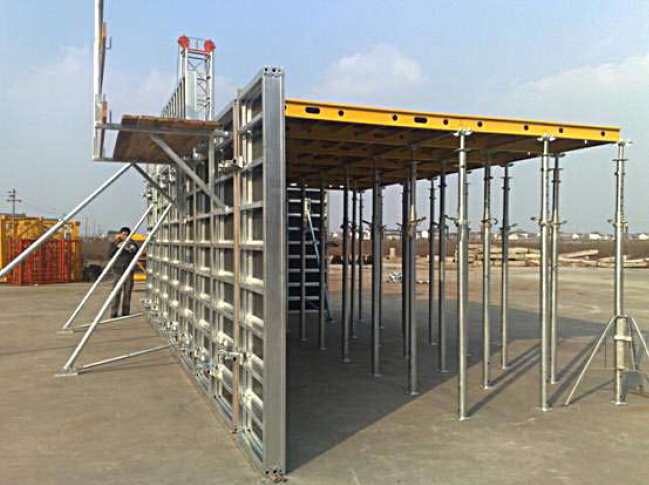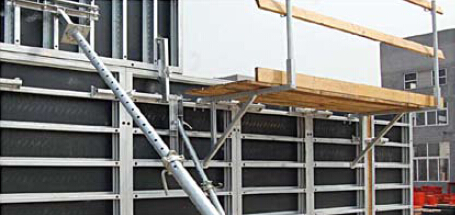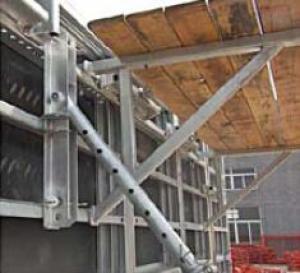Steel-Frame Working Platformfor Formwork and Scaffolding systems
- Loading Port:
- Tianjin
- Payment Terms:
- TT OR LC
- Min Order Qty:
- 50 m²
- Supply Capability:
- 1000 m²/month
OKorder Service Pledge
OKorder Financial Service
You Might Also Like
Steel-frame Formwork SF-140
Characteristics:
◆ Few parts for fast forming.
◆ Max. Concrete pressure: 80KN/m2.
◆ Hot-dip galvanized steel frame.
◆ The thickness of plywood is 18mm & the panel is 14cm.
◆ Compatibility with Hunnebeck Manto system due to similar edge profile.
System Details & Application:
◆ Neat joint and fast assembling with aligning panel clamp.
◆ Flexible panel arrangement and height extension.
◆ The selection of panels.
◆ Kinds of panel connectors.
◆ Corner clamp application.
◆ Length adjustment application.
◆ Height adjustment & aligning strut.
◆ Walkway bracket & platform.


- Q:Concrete, reinforcing steel for the labor price? 18 storey elevator apartment with a layer of underground carpentry, concrete, steel artificial price. (to the workers to do the Contractor) the problem added: steel, including the production and installation of a full set of artificial ha, concrete is mixed business. Template carpenter??? Concrete with nails??? Steel??? Including machine...Is the area of 10000 square meters of construction area template?How many tons of steel?
- Template carpenter according to the template surface calculation, according to 18 yuan /M2 (including nails)Concrete by cubic, according to 20 yuan /M3
- Q:What are the common accessories used with steel formwork?
- Steel formwork commonly utilizes various accessories such as form ties, wedges, form release agents, formwork clamps, and form liners. Form ties play a crucial role in securing the formwork and maintaining its position throughout the concrete pouring and curing stages. They are typically constructed from steel and are available in different lengths and designs to accommodate diverse formwork needs. Wedges, typically composed of steel or plastic, are essential in conjunction with form ties to firmly secure the formwork. They are inserted into the form tie to provide a tight grip and ensure stability. Form release agents are applied to the formwork surface to prevent concrete from adhering to it. By creating a barrier between the concrete and formwork, they facilitate easy removal of the formwork after the concrete has cured. Formwork clamps, made of steel and offered in various sizes and designs, are used to hold the formwork panels together and maintain proper alignment during concrete pouring. Form liners, typically constructed from plastic or elastomeric materials, are attached to the formwork prior to concrete pouring. They enable the creation of decorative patterns or textures on the concrete surface. Upon the concrete's curing, the form liners are removed, leaving behind the desired appearance. These accessories are frequently employed in conjunction with steel formwork systems to optimize efficiency and effectiveness during the construction process, resulting in high-quality concrete structures.
- Q:Is steel formwork suitable for high-rise construction?
- Yes, steel formwork is suitable for high-rise construction. Steel formwork systems offer high strength, durability, and stability, making them ideal for supporting the weight and pressures associated with tall buildings. They can withstand the repetitive use and provide a smooth surface finish, ensuring efficient construction processes and high-quality results in high-rise projects.
- Q:What are the different types of release agents used with steel formwork?
- There exist various release agents that can be utilized with steel formwork. Some of the most frequently encountered types encompass: 1. Water-based release agents: These release agents consist mainly of water, with additives like surfactants and lubricants. They are environmentally friendly and can be easily applied by spraying or brushing onto the steel formwork. By forming a thin film on the steel surface, water-based release agents prevent the concrete from adhering during the curing process. 2. Solvent-based release agents: Organic solvents serve as the carrier for the active ingredients in these release agents. They are effective in providing a smooth surface finish on the concrete and are often employed in situations where a higher level of release performance is required. Application is typically done through spraying or brushing, and the solvents evaporate quickly, leaving a thin film on the steel formwork. 3. Barrier release agents: These release agents are usually applied as a thick paste or gel, creating a physical barrier between the steel formwork and the concrete. They are commonly used when a high-quality surface finish is desired, such as in architectural concrete applications. Brushing or troweling the barrier release agents onto the steel formwork is the typical method of application. 4. Dry release agents: These agents come in powdered or granular form and are directly applied to the steel formwork. They create a non-stick surface by absorbing excess moisture from the concrete, thus preventing adhesion. Dry release agents are often employed in situations where other types of release agents may not be suitable, such as in cold weather conditions. 5. Form release oils: Petroleum-based products, known as form release oils, are frequently used in conjunction with steel formwork. They effectively establish a release barrier between the steel and the concrete, preventing adhesion. Application of form release oils is typically done through spraying or brushing, and they can be utilized in various concrete applications. The selection of the appropriate release agent is crucial and should be based on specific project requirements, including the desired surface finish, environmental considerations, and ease of application. Seeking guidance from professionals or consulting the manufacturer's recommendations can aid in determining the most suitable release agent for a particular steel formwork application.
- Q:Can steel formwork be used for precast concrete columns?
- Yes, steel formwork can be used for precast concrete columns. Steel formwork offers durability and strength, making it suitable for creating precise and complex shapes required for precast concrete columns. Additionally, steel formwork can be reused multiple times, making it a cost-effective option for precast concrete column production.
- Q:Can steel formwork be used for both interior and exterior concrete elements?
- Yes, steel formwork can be used for both interior and exterior concrete elements. Steel formwork is highly versatile and can be used in various construction applications. It is durable, strong, and capable of withstanding the pressure exerted by the wet concrete. Additionally, steel formwork offers excellent dimensional accuracy and can create smooth and uniform concrete surfaces. Whether it is for interior slabs, walls, or exterior foundations, columns, or beams, steel formwork is a reliable choice that can be used for both interior and exterior concrete elements.
- Q:What are the different types of edge protection used with steel formwork?
- To ensure safety and prevent accidents on construction sites, various types of edge protection are utilized with steel formwork. Here are some commonly used options: 1. Edge protection barriers: These sturdy barriers, typically constructed from materials like steel or aluminum, are installed along the formwork's edges. Their purpose is to physically obstruct workers from unintentionally falling off. These barriers are adjustable, making them easy to install and remove as needed. 2. Toe boards: Usually made of wood or steel, toe boards are positioned along the lower edge of the formwork. Their role is to act as a barrier, preventing tools, equipment, or debris from falling off. Additionally, they serve as a visual reminder for workers to exercise caution near the edge. 3. Handrails: Attached to vertical posts, handrails are horizontal bars placed along the formwork's edges. They offer workers a secure grip, aiding in balance and stability, especially when working at elevated heights. Safety regulations often mandate the installation of handrails in specific situations. 4. Safety nets: These nets are positioned beneath the formwork to catch any falling objects or debris. Typically crafted from robust mesh material, safety nets are designed to absorb the impact of such items. They prove especially beneficial during activities where there is a risk of objects falling off, such as concrete pouring or formwork removal. 5. Harnesses and lifelines: In high-risk scenarios, workers may be required to wear harnesses and employ lifelines to safeguard against falls. These systems consist of a harness worn by the worker, which is connected to a securely anchored lifeline. Harnesses and lifelines provide an additional layer of protection when edge protection alone may not suffice. It is important to consider project-specific requirements, local regulations, and the level of risk involved when selecting edge protection measures. Construction companies must thoroughly assess site conditions and implement appropriate measures to ensure worker safety.
- Q:How does steel formwork affect the schedule of concrete pouring?
- Steel formwork can have a significant impact on the schedule of concrete pouring. One of the major advantages of using steel formwork is its strength and durability, which allows for faster construction progress. Unlike traditional wooden formwork, steel formwork can be reused multiple times, leading to shorter construction cycles and faster completion times. The use of steel formwork also allows for a faster assembly and disassembly process. It requires less time to set up compared to wooden formwork, as it typically comes prefabricated or in standard sizes that can be easily assembled on site. This quick assembly process reduces the time needed for formwork installation, enabling concrete pouring to begin sooner. Additionally, steel formwork provides a smooth and uniform surface finish to the concrete. It eliminates the need for plastering or additional finishing work, saving time and effort. The smooth surface also reduces the curing time required for the concrete, as it allows for more efficient evaporation of moisture. Moreover, steel formwork is known for its superior strength and stability. This allows for a higher rate of concrete pouring, as it can withstand the pressure exerted by the wet concrete without deforming or collapsing. With steel formwork, larger concrete sections can be poured at once, reducing the number of pours required and consequently saving time. However, it is important to note that steel formwork requires careful planning and coordination to ensure a seamless workflow. The availability of steel formwork materials and equipment, as well as skilled labor, must be considered during the project scheduling process. Any delays in the procurement or fabrication of steel formwork can impact the concrete pouring schedule. In conclusion, steel formwork positively affects the schedule of concrete pouring by reducing construction time, providing a smooth surface finish, allowing for faster assembly and disassembly, and enabling larger concrete sections to be poured at once. However, proper planning and coordination are essential to maximize the benefits of steel formwork and avoid any potential delays.
- Q:What are the different types of steel formwork systems?
- Construction projects commonly utilize various types of steel formwork systems, which serve as temporary structures or molds to support concrete during pouring and curing. Below are several types of steel formwork systems commonly used: 1. Traditional steel formwork: This prevalent system involves connecting individual steel panels using clamps or pins. These panels can be adjusted to create different shapes and sizes, and they are straightforward to assemble and disassemble. 2. Modular steel formwork: This system relies on prefabricated steel modules that are interconnected to form larger formwork assemblies. The modules are lightweight and easy to handle, making them ideal for repetitive use in projects with consistent shapes and sizes. 3. Tunnel formwork: Specifically designed for tunnel or underground structure construction, this system utilizes interconnected steel panels to create a seamless, continuous mold. It is commonly employed in large-scale infrastructure projects like subway systems or underground parking garages. 4. Climbing formwork: This system is suitable for tall structures such as high-rise buildings or towers. It comprises vertically extendable steel formwork panels that are attached to a climbing mechanism. This mechanism facilitates lifting and repositioning of the panels at each level, enabling uninterrupted construction. 5. Slip formwork: For vertical structures like walls or columns, slip formwork is utilized. It involves a moving formwork that is continuously filled with concrete as it ascends. Steel rods or cables support the formwork, allowing for the swift construction of tall and straight structures. These examples represent only a portion of the diverse steel formwork systems available. The selection of the most suitable system depends on the project's specific requirements, including structure size, shape, complexity, desired construction speed, and cost-effectiveness.
- Q:What are the considerations when designing steel formwork for stairs?
- Several important considerations must be kept in mind when designing steel formwork for stairs. Firstly, it is crucial to carefully calculate and design the structural integrity and load-bearing capacity of the formwork. Stairs experience significant dynamic loads from people walking up and down, so the formwork must be able to support these loads without any deformation or failure. Accurately determining the dimensions and shape of the stairs is also essential to ensure a proper fit within the formwork. This involves considering the rise, tread, and overall dimensions of each step, as well as any landings or platforms that may be present. The formwork needs to be designed to accommodate these dimensions while providing a smooth and safe construction surface. The construction process and ease of installation should be taken into account as well. The steel formwork for stairs should be designed to be easily assembled, disassembled, and transported to the construction site. It should also allow for easy access during the construction process, ensuring that workers can safely and efficiently complete their tasks. Durability and longevity are crucial factors when designing steel formwork for stairs. While steel is a strong and durable material, it is important to consider the potential for corrosion and wear over time. The design should incorporate proper coatings and protective measures to prevent corrosion and ensure the formwork's longevity. Finally, safety is of utmost importance when designing steel formwork for stairs. The formwork should be designed to provide a secure and stable working platform for construction workers. This may involve incorporating handrails, non-slip surfaces, and other safety features to minimize the risk of accidents or falls during construction. In conclusion, when designing steel formwork for stairs, it is important to consider factors such as structural integrity, dimensions, ease of installation, durability, and safety. By carefully considering these factors, a well-designed steel formwork system can be created to efficiently and effectively construct stairs in a safe and reliable manner.
1. Manufacturer Overview |
|
|---|---|
| Location | |
| Year Established | |
| Annual Output Value | |
| Main Markets | |
| Company Certifications | |
2. Manufacturer Certificates |
|
|---|---|
| a) Certification Name | |
| Range | |
| Reference | |
| Validity Period | |
3. Manufacturer Capability |
|
|---|---|
| a)Trade Capacity | |
| Nearest Port | |
| Export Percentage | |
| No.of Employees in Trade Department | |
| Language Spoken: | |
| b)Factory Information | |
| Factory Size: | |
| No. of Production Lines | |
| Contract Manufacturing | |
| Product Price Range | |
Send your message to us
Steel-Frame Working Platformfor Formwork and Scaffolding systems
- Loading Port:
- Tianjin
- Payment Terms:
- TT OR LC
- Min Order Qty:
- 50 m²
- Supply Capability:
- 1000 m²/month
OKorder Service Pledge
OKorder Financial Service
Similar products
New products
Hot products
Related keywords
























